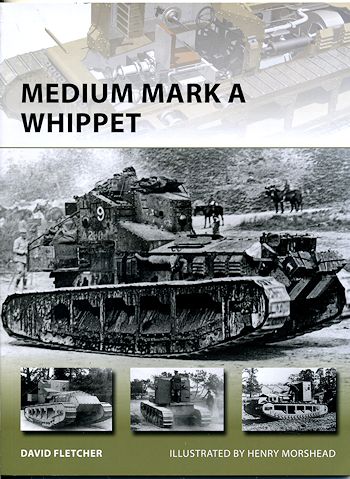 This
next title in Osprey's New Vanguard series is on another interesting WWI tank,
the British Medium Mark A Whippet. This was, as the name implies, a medium tank,
at least compared to the heavy Mark I-V versions that so many of us know. In
this case, it was hoped that the lighter Whippet would be faster and more of a
'cavalry' tank that the lumbering Mark I-V versions. Though 'cavalry' implies
speed, things are relative when it comes to WWI armor, but 8 mph was better than
what had come before.
This
next title in Osprey's New Vanguard series is on another interesting WWI tank,
the British Medium Mark A Whippet. This was, as the name implies, a medium tank,
at least compared to the heavy Mark I-V versions that so many of us know. In
this case, it was hoped that the lighter Whippet would be faster and more of a
'cavalry' tank that the lumbering Mark I-V versions. Though 'cavalry' implies
speed, things are relative when it comes to WWI armor, but 8 mph was better than
what had come before.
To get this speed, the Mark A was powered by two 7.7 liter four cylinder
engines and had less armor than the heavier tanks. It also carried a smaller
crew and such was the placement of the engines, in the front of the vehicle,
than any repair needed had to be done outside the tank, putting the crew under
fire during combat. It still had no turret and was rather lightly armed, never
actually carrying more than machine guns. Hence no 'male' or 'female'
appellation. It was also very difficult to drive with one engine operating
tracks on one side and the other taking care of the other side. The driver had
to be very good at keeping the two engines operating about the same power output
to even go in a straight line. Add to that the intolerable conditions with the
heat and fumes from the two engines and it was not a vehicle for any but the
strong and fit. The main access door was at the back and often the other two
crew members would have that door open and be standing outside the hull. The
poor driver did not have that option and was left sweltering inside.
Not many in the British army actually knew what to do with it. However,
it did see action in the last year of the war and when used properly, was quite
effective. It had enough armor to fend off machine gun fire and its speed was
such that it was able to chase enemy troops away from their emplacements,
opening the way for friendly troops to occupy their positions.
They were also sent to other theaters of operation in very small numbers
of less than a handful. Mostly they were used for show and after the war quickly
disappeared from British service.
Of course, there were follow-on tanks that include the Medium Mark B,C,D and
a Studebaker built tank that were built, but none saw combat, though several did
hang on for many years. The story of these vehicles covers the last quarter or
so of the book.
Typical of the series, we are provided with a full development history
of the tank as well as its use in combat. There are a goodly number of nice
period photos and we are also treated to some excellent art work and
illustrations along the way. It's subjects like this that make the New Vanguard
series so well received by enthusiasts and this one is no exception. A great
read and I know you will learn from it.
June 2014
For more on the complete line of Osprey books,
visit www.ospreypublishing.com. In the US, it is
Osprey Direct at 44-02 23rd St, Suite 219, Long Island City, NY 11101., where you can
get a catalogue of available books.
If you would like your product reviewed fairly and
fairly quickly, please
contact
the editor or see other details in the
Note to
Contributors.
 This
next title in Osprey's New Vanguard series is on another interesting WWI tank,
the British Medium Mark A Whippet. This was, as the name implies, a medium tank,
at least compared to the heavy Mark I-V versions that so many of us know. In
this case, it was hoped that the lighter Whippet would be faster and more of a
'cavalry' tank that the lumbering Mark I-V versions. Though 'cavalry' implies
speed, things are relative when it comes to WWI armor, but 8 mph was better than
what had come before.
This
next title in Osprey's New Vanguard series is on another interesting WWI tank,
the British Medium Mark A Whippet. This was, as the name implies, a medium tank,
at least compared to the heavy Mark I-V versions that so many of us know. In
this case, it was hoped that the lighter Whippet would be faster and more of a
'cavalry' tank that the lumbering Mark I-V versions. Though 'cavalry' implies
speed, things are relative when it comes to WWI armor, but 8 mph was better than
what had come before.